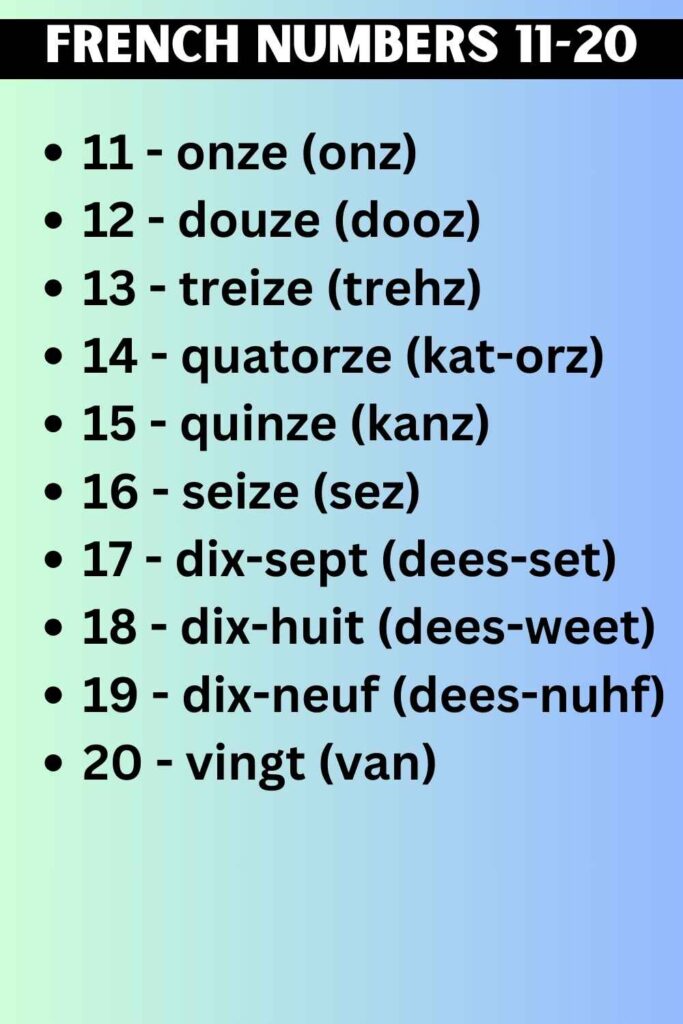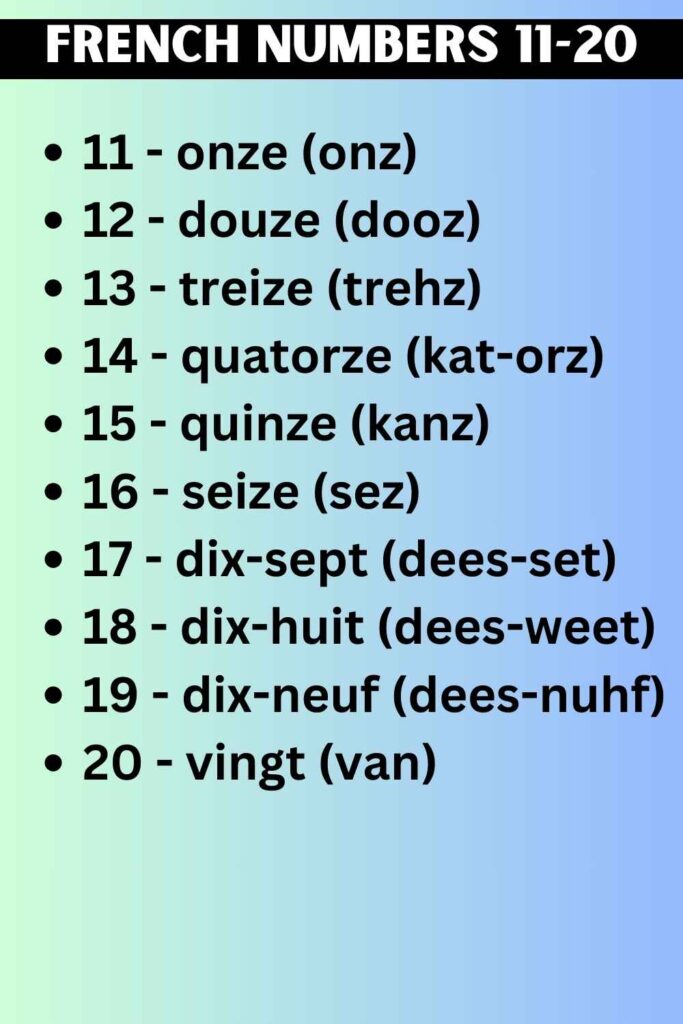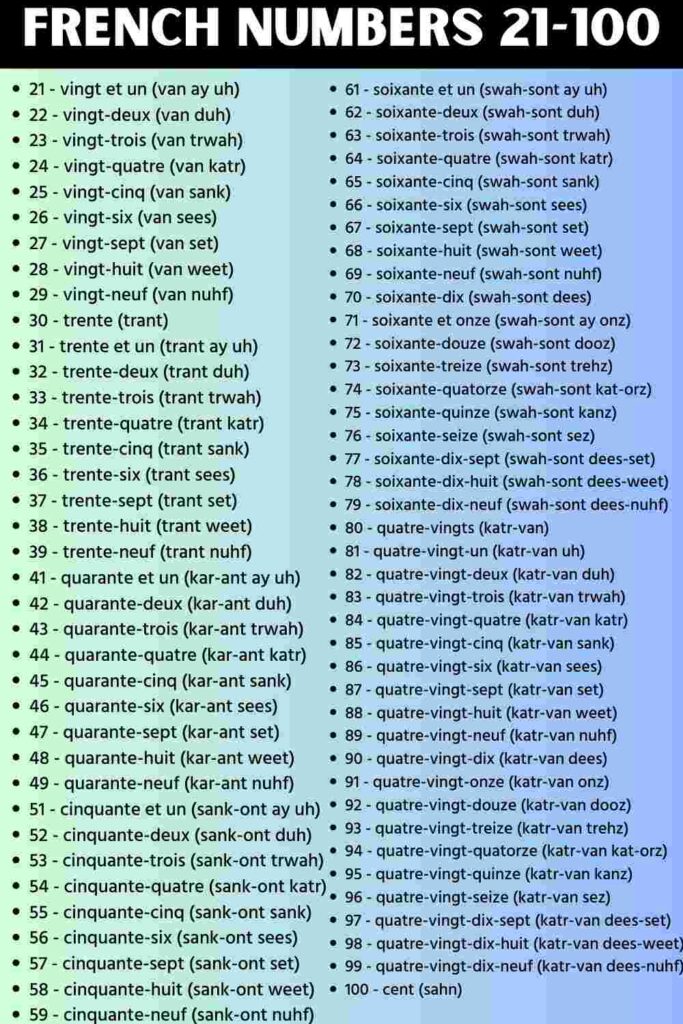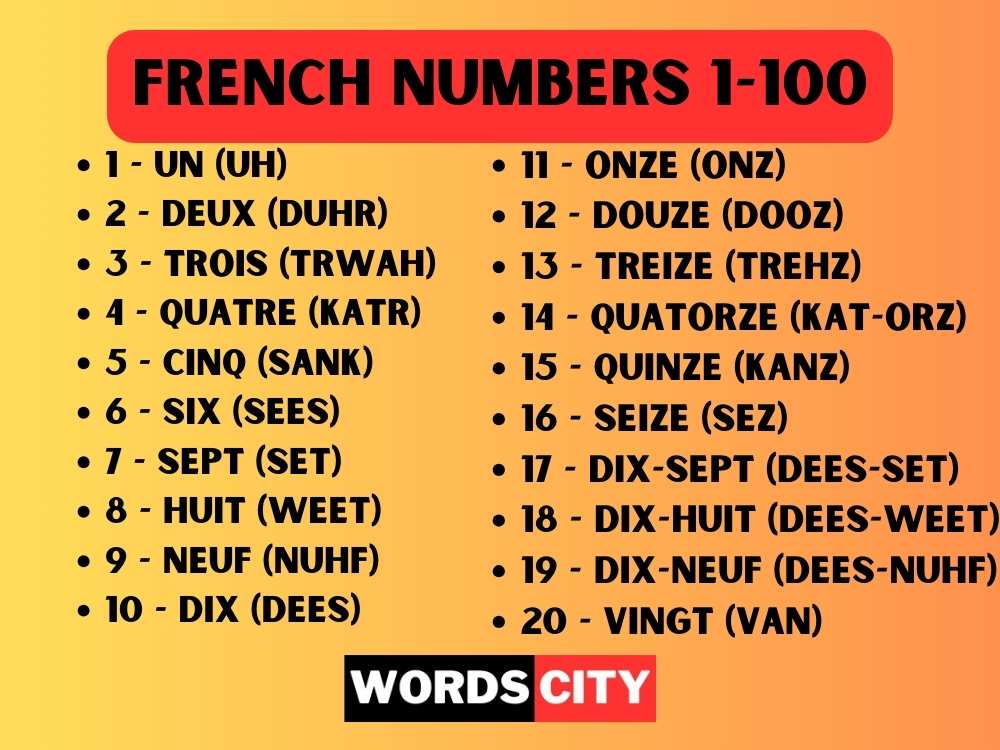Understanding French numbers is a crucial part of mastering the French language. Whether you’re planning to visit France, studying French, or simply looking to enhance your language skills, knowing how to count in French is essential. This guide will take you through French numbers from the basics to more advanced concepts, providing you with the knowledge and confidence to use them effectively.
Table of Contents
French Numbers
Learning numbers in any language is like laying the foundation of a house. It’s fundamental, practical, and opens the door to a myriad of other language skills. In French, numbers are not just about counting; they’re integral to daily conversations, telling time, dealing with money, and much more.
Imagine you’re in a French café ordering coffee or shopping at a market. Being able to understand and use numbers confidently will make your interactions smoother and more enjoyable. So, let’s embark on this numerical journey together and make learning French numbers an enjoyable experience!
Basic French Numbers 1-10
To begin, let’s familiarize ourselves with the basic numbers from 1 to 10. These are the building blocks of counting in French:
- 1 – un (uh)
- 2 – deux (duhr)
- 3 – trois (trwah)
- 4 – quatre (katr)
- 5 – cinq (sank)
- 6 – six (sees)
- 7 – sept (set)
- 8 – huit (weet)
- 9 – neuf (nuhf)
- 10 – dix (dees)

Pronunciation Tips
French pronunciation can be tricky. Here are some tips:
- Un: The “n” is nasalized, meaning you let air pass through your nose.
- Deux: The “x” is silent, and the “eu” sounds like the “u” in “fur.”
- Trois: The “oi” sounds like “wah.”
- Quatre: The “qu” is pronounced like “k.”
Practice these numbers until you feel comfortable with their pronunciation. They’re the foundation for understanding higher numbers.
French Numbers 11-20
Next, we expand our range to 11 through 20. These numbers introduce some unique patterns:
- 11 – onze (onz)
- 12 – douze (dooz)
- 13 – treize (trehz)
- 14 – quatorze (kat-orz)
- 15 – quinze (kanz)
- 16 – seize (sez)
- 17 – dix-sept (dees-set)
- 18 – dix-huit (dees-weet)
- 19 – dix-neuf (dees-nuhf)
- 20 – vingt (van)

Patterns to Note
- Dix-sept, dix-huit, dix-neuf: These numbers are formed by combining “dix” (ten) with the numbers 7, 8, and 9.
- Vingt: This word means twenty, and it’s pronounced with a nasalized “n.”
French Numbers 21-30
With the basics covered, let’s look at numbers 21 through 30. Here, we start to see how numbers are formed by combining units with multiples of ten:
- 21 – vingt et un (van ay uh)
- 22 – vingt-deux (van duh)
- 23 – vingt-trois (van trwah)
- 24 – vingt-quatre (van katr)
- 25 – vingt-cinq (van sank)
- 26 – vingt-six (van sees)
- 27 – vingt-sept (van set)
- 28 – vingt-huit (van weet)
- 29 – vingt-neuf (van nuhf)
- 30 – trente (trant)
Usage Patterns
- Vingt et un: The “et” means “and,” which is used between 20 and 1.
- Trente: The “trente” (thirty) follows a simple pattern without needing “et” for numbers 21-29.
Read Also: How to Count Italian Numbers from 1-100 : A Complete Guide to Counting in Italian
French Numbers 31-100
As we progress, the numbers 31 to 100 use similar patterns with more complexity:
- 31 – trente et un (trant ay uh)
- 32 – trente-deux (trant duh)
- 33 – trente-trois (trant trwah)
- 34 – trente-quatre (trant katr)
- 35 – trente-cinq (trant sank)
- 36 – trente-six (trant sees)
- 37 – trente-sept (trant set)
- 38 – trente-huit (trant weet)
- 39 – trente-neuf (trant nuhf)
Key Points
- Trente et un: This means “thirty and one,” and is used to form numbers from 31 to 39.
- Combining Tens and Units: For numbers 32 to 39, simply combine “trente” with the units (deux, trois, etc.).
Pronunciation Tips
- Trente: The “trente” is pronounced with a nasal “n.”
- Un: Remember that “un” has a nasal sound, which might be challenging.
Numbers 41-50: Patterns and Construction
41-49
- 41 – quarante et un (kar-ant ay uh)
- 42 – quarante-deux (kar-ant duh)
- 43 – quarante-trois (kar-ant trwah)
- 44 – quarante-quatre (kar-ant katr)
- 45 – quarante-cinq (kar-ant sank)
- 46 – quarante-six (kar-ant sees)
- 47 – quarante-sept (kar-ant set)
- 48 – quarante-huit (kar-ant weet)
- 49 – quarante-neuf (kar-ant nuhf)
Key Points
- Quarante et un: Similar to “trente et un,” this pattern is used for numbers from 41 to 49.
- Combining Units: Use “quarante” (forty) and add the units (deux, trois, etc.) directly.
Pronunciation Tips
- Quarante: Pronounced with a silent “e” and a nasal “n.”
- Ensuring Clarity: Practice blending “quarante” with the units to achieve a natural flow.
Numbers 51-60: Transitioning to the Next Decade
51-59
- 51 – cinquante et un (sank-ont ay uh)
- 52 – cinquante-deux (sank-ont duh)
- 53 – cinquante-trois (sank-ont trwah)
- 54 – cinquante-quatre (sank-ont katr)
- 55 – cinquante-cinq (sank-ont sank)
- 56 – cinquante-six (sank-ont sees)
- 57 – cinquante-sept (sank-ont set)
- 58 – cinquante-huit (sank-ont weet)
- 59 – cinquante-neuf (sank-ont nuhf)
Key Points
- Cinquante et un: Use this pattern for numbers 51 to 59.
- Combining with Units: Just like in previous ranges, “cinquante” (fifty) combines with units directly.
Pronunciation Tips
- Cinquante: The “cinquante” has a soft “t” sound, and “et un” should be clearly pronounced.
Numbers 61-70: The Sixty and Seventy Series
61-69
- 61 – soixante et un (swah-sont ay uh)
- 62 – soixante-deux (swah-sont duh)
- 63 – soixante-trois (swah-sont trwah)
- 64 – soixante-quatre (swah-sont katr)
- 65 – soixante-cinq (swah-sont sank)
- 66 – soixante-six (swah-sont sees)
- 67 – soixante-sept (swah-sont set)
- 68 – soixante-huit (swah-sont weet)
- 69 – soixante-neuf (swah-sont nuhf)
70-79
- 70 – soixante-dix (swah-sont dees)
- 71 – soixante et onze (swah-sont ay onz)
- 72 – soixante-douze (swah-sont dooz)
- 73 – soixante-treize (swah-sont trehz)
- 74 – soixante-quatorze (swah-sont kat-orz)
- 75 – soixante-quinze (swah-sont kanz)
- 76 – soixante-seize (swah-sont sez)
- 77 – soixante-dix-sept (swah-sont dees-set)
- 78 – soixante-dix-huit (swah-sont dees-weet)
- 79 – soixante-dix-neuf (swah-sont dees-nuhf)
Key Points
- Soixante-dix: Means “sixty-ten,” and is used for 70-79.
- Combining Units: Numbers 71-79 are formed by adding units to “soixante-dix.”
Pronunciation Tips
- Soixante-dix: The “dix” sounds like “dees.”
- Complex Numbers: Practice saying each number in sequence to get comfortable with the structure.
Numbers 80-100: Completing the Range
80-89
- 80 – quatre-vingts (katr-van)
- 81 – quatre-vingt-un (katr-van uh)
- 82 – quatre-vingt-deux (katr-van duh)
- 83 – quatre-vingt-trois (katr-van trwah)
- 84 – quatre-vingt-quatre (katr-van katr)
- 85 – quatre-vingt-cinq (katr-van sank)
- 86 – quatre-vingt-six (katr-van sees)
- 87 – quatre-vingt-sept (katr-van set)
- 88 – quatre-vingt-huit (katr-van weet)
- 89 – quatre-vingt-neuf (katr-van nuhf)
90-100
- 90 – quatre-vingt-dix (katr-van dees)
- 91 – quatre-vingt-onze (katr-van onz)
- 92 – quatre-vingt-douze (katr-van dooz)
- 93 – quatre-vingt-treize (katr-van trehz)
- 94 – quatre-vingt-quatorze (katr-van kat-orz)
- 95 – quatre-vingt-quinze (katr-van kanz)
- 96 – quatre-vingt-seize (katr-van sez)
- 97 – quatre-vingt-dix-sept (katr-van dees-set)
- 98 – quatre-vingt-dix-huit (katr-van dees-weet)
- 99 – quatre-vingt-dix-neuf (katr-van dees-nuhf)
- 100 – cent (sahn)
Key Points
- Quatre-vingts: Means “four twenties,” used for 80-89.
- Combining with Tens: Numbers 90-99 use “quatre-vingt-dix” as the base.
Pronunciation Tips
- Quatre-vingts: Notice the silent “t” at the end.
- Cent: Pronounced with a silent “t” unless followed by another number (e.g., “cent un”).
Combining Patterns
- Soixante-dix: This means “sixty-ten,” which is used for numbers 70-79.
- Quatre-vingts: This means “four-twenties,” used for 80-89. The pattern repeats for 90 with an additional “dix.”

French Numbers Beyond 100
Counting beyond 100 involves understanding thousands and hundreds:
- 101 – cent un (sahn uh)
- 200 – deux cents (duhr sahn)
- 1,000 – mille (meel)
- 10,000 – dix mille (dees meel)
Constructing Larger Numbers
- 2,345 – deux mille trois cent quarante-cinq (duhr meel trwah sahn kar-ant sank)
- Deux mille: Two thousand
- Trois cent: Three hundred
- Quarante-cinq: Forty-five
Ordinal Numbers in French
Ordinal numbers indicate rank or position:
- 1st – premier/première (pruh-myay / prem-yair)
- 2nd – deuxième (dyez-yem)
- 3rd – troisième (trwah-zyem)
- 4th – quatrième (kat-ree-em)
Gender and Number Agreements
- Premier: Used for masculine singular (e.g., premier ministre).
- Première: Used for feminine singular (e.g., première dame).
Common Mistakes and Tips for Learning French Numbers
Learning French numbers can come with challenges. Here are some common mistakes and tips to avoid them:
Common Mistakes
- Mispronunciation: Pay attention to nasal sounds and silent letters.
- Confusing Patterns: Be mindful of the unique patterns for 70-99.
Tips for Improvement
- Practice Regularly: Use flashcards or apps for daily practice.
- Engage in Real-Life Practice: Try using numbers in conversations or while shopping.
- Interactive Exercises: Participate in quizzes and exercises to reinforce your learning.
Conclusion
Mastering French numbers is a fundamental skill that will greatly enhance your ability to communicate in French. From basic counting to understanding complex numbers and ordinal terms, this guide has covered the essentials to help you feel confident in using French numbers. Keep practicing, and soon you’ll find counting in French becomes second nature. Bonne chance et bon apprentissage!


1 thought on “Mastering French Numbers 1-100 : A Comprehensive Guide”